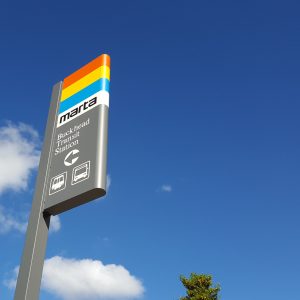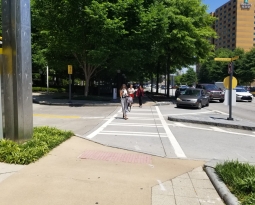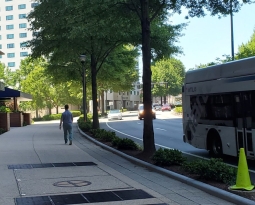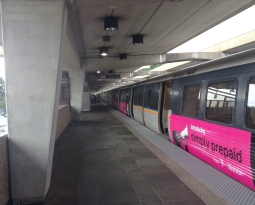Fewer Square Feet, More Commute Options: Q&A with Paul Ribes, COO of Homrich Berg
 A company move is an excellent time to spark a change in employee commute patterns — especially if your new office space comes with parking spaces for only half of your employees!
A company move is an excellent time to spark a change in employee commute patterns — especially if your new office space comes with parking spaces for only half of your employees!
Paul Ribes, Chief Operating Officer of Homrich Berg, a national independent wealth management firm, maximized the opportunities presented by his company’s move in 2018. When looking for a new office space, Ribes and the Homrich Berg team prioritized an office environment with lots of natural light and a welcoming atmosphere that reflects the company’s core values of team work and client service. They also wanted a location with more options for transportation. It all came together at Three Alliance Center, an office tower with floor-to-ceiling glass that is located immediately off GA 400 and within a short walk of the Buckhead MARTA station.
Paul and his team used this proximity to transit as the cornerstone for an innovative mobility program. His grassroots leadership style has translated into broad employee support and participation. Homrich Berg’s success is a great model for other employers, so we asked Paul and his team to share their story with you.
What prompted you to create a mobility program for your employees?
In June 2018, we moved into a new, custom-made office, perfectly fit for our collaborative culture. Our new office has a great location that is convenient for the majority of our clients and employees, but it also came with a new challenge: 117 seats and only 65 parking spaces in the building! We knew we needed to maximize our location next to the Buckhead MARTA station and begin to promote alternative forms of transportation.
How did you establish a good foundation for a successful HB Commuter Benefits program?
The key to success for any company program is to understand how many people are interested before you begin. If you don’t have employees who want it, it won’t be successful. We polled employees and discovered that there was a group of people who wanted commute alternatives. Then we brought in experts – Livable Buckhead – to help us create the program and promote it.
We also knew that it would be important to debunk myths about public transportation. Providing solid research and educational programs helped on that front, but it was critical to find a handful of internal champions who tried alternatives and shared their comparative experiences with their peers.

Three Alliance Center, the state of the art architecture and amenities makes this trophy tower ideal for the most sophisticated companies that call Atlanta home.
How have you encouraged participation in the program?
Incentives alone are a waste of money. Our key to engagement was the combination of expert advice on better commuter options, trustworthy peers experiencing better ways to work, and a sensible commuter package.
The first thing we did was bring in Livable Buckhead as an expert to educate our small group of champions on the alternative commuter options (MARTA, carpooling, walking, etc.). Our champions tried various options, and then we held a Q&A panel session where our champions shared their experiences with the entire firm.
Livable Buckhead also participated in an all-company meeting where they talked to our employees about MARTA, provided pamphlets with simple instructions and train times/routes, and provided advice to each individual person on their best commuter options. In a separate all-company benefits meeting, we walked our employees through the HB Commuter package to help them pick the option that was best for them, emphasizing that both occasional and regular use of alternative transportation was reimbursed.
What kind of program did you put in place? What benefits do you offer?
Our HB Commuter Benefits package is more economical for people choosing alternative transportation over driving by paying them the equivalent of a monthly transit pass with the added flexibility of reimbursement for five Uber/Lyft rides and five parking passes per month. The program also incentivizes people who regularly drive to work by reimbursing them for occasionally using alternative transportation.
What were some of the key selling points when introducing it to employees?
Driving in Atlanta traffic is not only stressful, but entirely unpredictable day to day. In our education and comparative experiences, we asked everyone to focus on their quality of time commuting: not driving with some of the most aggressive drivers in the country, being free to check emails on the train, time to prepare notes for an upcoming meeting, time to unwind after a long day, and even time for a nice short walk.
What started as solving a parking capacity issue and providing a good employee benefit package turned into giving many of our employees a better way to get to work.

The Buckhead MARTA station was opened on June 8, 1996 and serves 2,700 rider daily. In 2014, new pedestrian bridges were built across both sides of GA 400, allowing better access to Alliance Center on the east and Tower Place on the west.
What kind of results have you seen so far?
In the last nine months, the percentage of people using alternative transportation increased from 7% to 22% plus another 9% tried it at least once. We also have seen a pretty amazing increase in our favorable team collaboration ratings from 89% to 98%. When people are less stressed and happier, they like each other more and work better together, and that’s a very good thing for everyone!
Are there any other insights you’d like to share with employers that are considering a program like yours?
Sustainability is not just for green loving dreamers, it is a very practical change to a better way of life for everyone. Sustainability programs do not require rocket science. The changes we made required a small group of energetic people to work out a better alternative, and then an investment in education campaigns and incentives to change.
Keep in mind, there are better commuter options for many people, but not everyone, so focus on the people who can be helped.
Also, be sure to encourage open sharing of both good and bad experiences with alternative options. Don’t worry about perfecting public transportation — the driving pains will significantly outweigh the problems with public transportation for many people.
Paul joined Homrich Berg in 2013 as Chief Operating Officer. In this role, he is responsible for aligning employee engagement and team structure with the firm’s vision and strategy, as well as overseeing day-to-day operations, technology, administration, and major projects. Paul is also the newest addition to Livable Buckhead’s board of directors.








